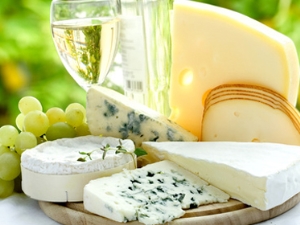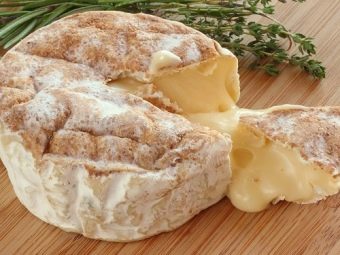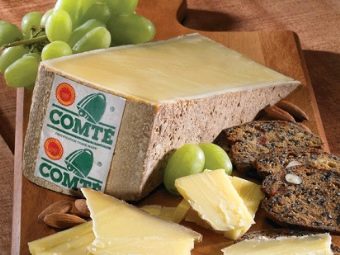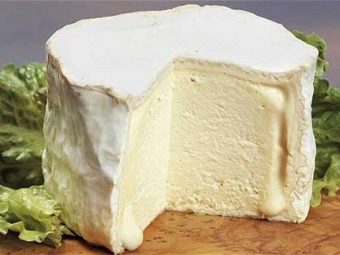French cheese: types and famous varieties

One famous French politician talked about how difficult it is to govern a country where there are several hundred sorts of cheese.France can rightly be called the capital of cheese making. Here, the dairy product is not treated as a snack or a component of a sandwich swallowed in the morning on the go. Eating cheese is a special ritual for the French, and he himself is a full-fledged, highly respected dish that is almost deified.
Classification
In each city and province, moreover, a special kind of cheese is created in a small village. Some of them are known and loved around the world. Others have the opportunity to enjoy only French gourmets. Technology of preparation of the product is stored in the strictest secret and handed down from generation to generation in an unchanged form. In the business of cheese making, tradition, experience and reputation are much more important than momentary success.
By raw materials, which is taken for production, cheeses are divided into cow, sheep and goat. In some cases (very rarely) they use milk from two types of animals. For each variety, it is important to take only certain milk. Animals eat different feeds, live in different conditions. The taste and quality of the final product directly and strongly depends on this.
Traditionally, cheeses are divided into different types, including aging. They are:
- young;
- fresh aged;
- soft with a hard white crust;
- semi-solid;
- solid;
- cheeses with a blue or greenish mold inside (it is unusual for many to smell);
- flavored (with herbs).
In the capital of fashion and its provinces can meet all of these varieties. If in our country semisolid grades are used more often, then the French simply adore spreading soft cheese on fresh crisp bread. In favorites they have both blue and solid varieties.
For justice, it should be noted that this classification is very common and generally accessible for understanding. But they also divide products into manufactured in the industry and manually. Cheese can be subjected to heat treatment or pressing, and can mature under its own weight. They also achieve readiness in different conditions: basements and storages with a special microclimate and temperature, in the sun, in caves, in cells at the plant.
Forms
Many of us are accustomed to the traditional round-headed cheese. However, in France there is no such thing. Each cheese has a recipe fixed for itself for centuries, color and, of course, shape. There are cheeses of square, rhombic, rectangular, cone-shaped, cylindrical, spherical and other forms. Recently even fantasy blanks have appeared, for example, in the form of hearts or ingots.
Due to this variety and cooking features of each type of product. Thus, the disk form allows the cheese to ripen most evenly. The cone-shaped form is used for sheep cheeses due to the fragility of their structure. And semi-hard and hard cheeses of peasant production have long been made in the form of a square or a triangle.
It is worth mentioning the color variations of French cheeses. In addition to the usual golden and orange eyes, you can easily find black, white, red, blue, purple, green cheeses.
In the set there are aromatic versions of handwork, flavored with spices and decorated with herbs. Often each such work of art exists in a single variant. And every bar in its own way is unique in its taste and appearance.
Description of famous varieties
In France, every cheese has its own history, legend and a clear idea why it is cooked this way, and not differently. They justly admit that cheese making in this country is akin to art. It does not like haste and too serious a relationship. Light, sparkling notes, like the character of the French themselves, accompany in their cheeses sustained basic taste qualities. And the aroma of most varieties with honey, nutty, creamy or herbal notes brings to mind the winged definition of “food of the gods”.
Among the great variety of the finest varieties, some of the most famous and beloved can be distinguished, as well as the most rare and even unknown to many.
- Universal Camembert, made from cows milk, earned the national love and popularity both at home and abroad. Intense, but dull taste, wide use in the preparation of different dishes and a democratic price category made this semi-solid variety a favorite among many.
- Solid variety of French cheese Conte named after the localization of its production - the region of Franche-Comte. This is one of the rarest species. It is produced in very limited quantities in an artisanal way. A recipe of production has remained unchanged for several centuries. Milk of cows is used as raw material; they graze at a height of about four hundred meters. Cheese has a very tender flesh with creamy taste and sweetish fruit notes. Due to its good melting ability, cheese can be used in the preparation of delicious dishes (including fondue, first courses, and exquisite sauces).
- Young Saint-Necther ripens in one to two months and is made on rennet ferment. The classic yellow color and delicate texture of the cheese complement the very bright spicy-nutty flavors. Above the cylindrical flat head has a hard crust with a whitish bloom.
- Soft Reblochon produce from live unpasteurized milk of cows in Savoylocated in the Alps. Sweet cheese is made in the shape of a circle. It ripens no longer than a month and, when ready, has a yellow-orange crust with a whitish bloom. The origin of the name of this cheese is interesting. It is believed that it comes from the French word, which is translated by the concept of "repeated milking of a cow." The fact is that in the Middle Ages the peasants were forced to pay tax after each milk yield of their cow. But they have managed not to finish the cows with the investigators. And when they left, they milked the cow again. From this milk and prepared excellent Reblochon.
- Cheese Muenster - one of the most ancient soft species. It is believed that the monks of the early Middle Ages had a hand in its creation. Meat food was banned most of the time, so they received the necessary protein from cheese. Prepare it from cow's milk for about three weeks. Twice a day, the heads are washed with water from a spring, therefore it is also called “washed”. It has a reddish crust and a yellow interior with small holes. Fans appreciate it for the sharpness in taste and pleasant aroma.
- Roquefort – the well-known noble blue cheese with mold It is made from pasteurized sheep milk. It has a salty taste and strong smell. With prolonged exposure, this precious variety acquires a nutty flavor. It is ideal as a separate dish or as part of a salad.
- Cantal from the central region of France (Auvergne region) is a hard species.. It is produced according to ancient technologies in large factories and in small cheese factories. The taste at the same time, of course, will vary and also depend on the ripening period. The older the age of the cheese, the sharper the taste it has. Young immature heads have a rather tender milky-nutty taste.
- Soft and very smelling Emmental surprise with a sweet spicy taste with a characteristic spicy twist. When you cut the cheese can be seen quite large voids. They appear because of the peculiarities of the technological process of preparation, in which special bacteria emit gas escaping through these layers and voids. Traditionally, such a product is made and served in a bark of bark.
- Salers - a rare jewel of traditional cheese making in France. It is known that the history of its manufacture has more than one millennium. To date, create it only by hand.It is made in small farms in central areas. It gets its special taste due to the milk of cows that feed exclusively on juicy grass in the Alps.
- Francis is an exquisite variety for connoisseurs.. It is prepared from a mixture of cow's milk of two types, with the result that it gets a gentle, creamy, but very rich taste. And notes of noble mildew add to it a sharp highlight. It is said that he was especially revered at the court of Francis I himself.
- Legendary Valance, according to the French, was presented by Emperor Napoleon. It happened by chance. After an unsuccessful campaign in Egypt, he came across the head of this cheese, and he carried the sharp top of it with a saber. So the form of the truncated pyramid turned out. Traditionally, for the greatest preservation of the crust sprinkled with ashes, on top of which appears white mold plaque. Because of this, the cheese apparently has an unusual ashen color. Its taste will appeal to many: gentle, sweet, with the aroma of hazelnuts.
- The pearl of Normandy Livaro has been produced since the Middle Ages.. He is often called the "colonel" for appearance similar to shoulder straps: the head of a bright orange-yellow color is wrapped with five strips of special grass. Spicy Picodon is made from goat's milk in the area of the Rhone River. He will delight lovers of spicy taste, which is reflected in its very name. The delicacy has a long exposure and, as it ripens, it gets increasingly dense pulp and rich shade of noble taste.
- Lovers of the unusual will like another brainchild of medieval monks - cheese Shawrs, which appeared in the XIV century. It is beautiful for its bright creamy taste and smell, resembling the aroma of fresh champignons. Small heads to half a kilo weight ripen in dry rooms, buried in straw. In order for the finished product to get its extraordinary smell, it is wrapped by craftsmen in sheets of plane tree.
How to choose the most delicious product?
Taste preferences for all people are different. Someone will be attracted by the unusual aroma of mushrooms or the taste of nuts, and someone spicy pepper. Herbal or fruity taste is different, for others the presence of noble blue mold threads in cheese will be important.
If you need to choose a new unusual type of cheese, you should taste it beforehand. To the characteristic taste revealed correctly, you should do it in accordance with the recommendations of professionals in their field.
Usually chosen from a dozen varieties, cut into very thin slices. They serve well-baked cereal bread. For each type of cheese is given a separate fork, so that the aftertaste is not lost and the flavors are not mixed. To take cheese from a special plate (or board) should not be hands, but a special device. This is a cheese knife, but it looks like a fork with two blunt teeth. It is on her thin slices and sent to the mouth. Naturally, between samples of two different types, one should wait for a while, and not jam one cheese with another.
Fresh varieties are suitable for those who love dull delicate taste. They are soft in texture and have no crust. Differ in light color and a smooth damp surface. Rarely they have a sour taste, more often - a gentle milky or unopened creamy.
- Fresh aged cheeses also have a tender flesh, but are covered in a hard crust.. They have interesting herbal tones in a sweetish taste and are usually made from goat's milk.
- Soft cheese is very different in consistency: mealy, granular, melting. It has an unusual flavor and taste of mushrooms. There are varieties with subtle bitterness.
- Mature species have a shade of creamy mushroom soupthat is especially appreciated by gourmets around the world.
- Semi hard cheeses are almost universal.. Choosing such a head, it is difficult not to please any discerning connoisseur, since in France there are a lot of them. An abundance of tastes, textures and colors will delight any collector.Everyone will be able to pick up a favorite or a new taste for himself, no matter where in the country he is.
- Hard cheeses will be appreciated by lovers of cooking various complex dishes. They are usually made in the form of large flat heads with a rough surface. The more impressive the age of the cheese, the better its rich taste with honey, spicy or nutty notes will be revealed.
- Flavored species have become widely known relatively recently.. But their invention dates back to the XVI century. Their highlight is in addition to them in the production of various herbs, various combinations of spices and even pieces of fruit. These additional components in no way interrupt the basic taste, but give it a special charm. Such cheeses are cooked by hand and sometimes dyed with natural dyes.
Best Cheese Tips
The French have their reverent attitude to this beloved delicacy. They will not understand his use hastily in the company of a huge piece of bread and a cup of tea. Cheese is eaten, enjoying every shade of taste that it carries, like notes of the aroma of a rare perfume. The complex taste is revealed gradually, especially in mature varieties. Therefore, it is recommended to eat it in its pure form, at least those varieties that you try for the first time.
But the French do not consider shameful to complement the delicacy with semi-sweet or semi-dry drinks. In their opinion, one taste helps better to open up and set off another.
In the next video you will find a tasting of the ten best varieties of French cheese.




































